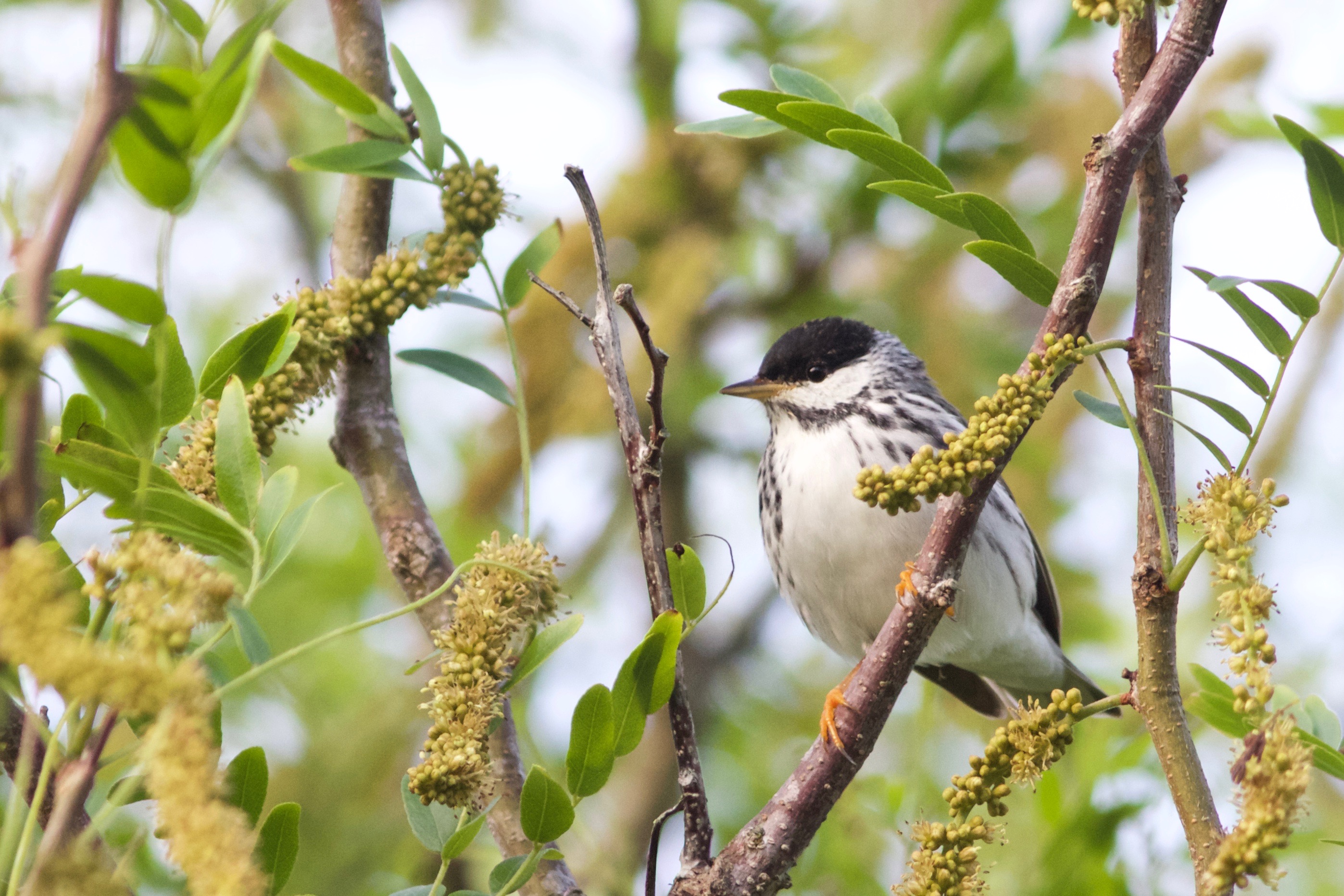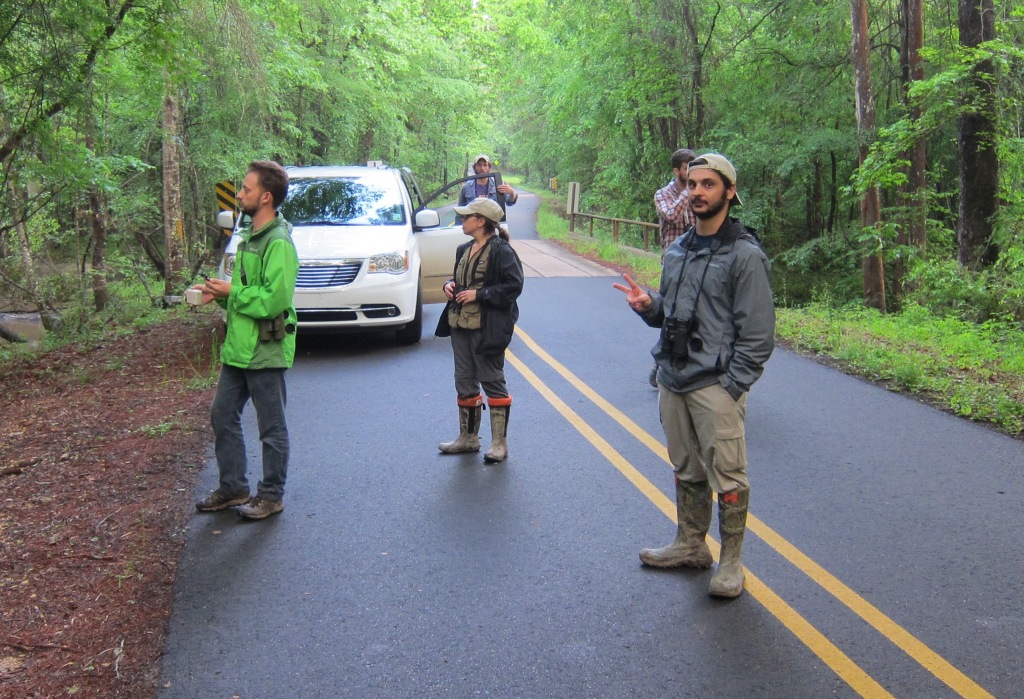Big Day Account 2016
05/02/2016

Blackpoll Warbler. Photo by Oscar Johnson Photo by Oscar Johnson
Most people in Baton Rouge probably didn’t have plans for 11:40 p.m. on Thursday night, 21 April 2016. Six LSUMNS ornithology graduate students, however, were meeting at this time after a few hours (at best!) of sleep to attempt breaking the record for most bird species seen or heard in the state of Louisiana in a day. Crazy? Perhaps, but it is a great excuse to get outside and see a lot of birds during spring migration when bird diversity is at its peak in the state. Also, this Big Day event is an annual tradition that raises funds for graduate student research in ornithology. The Big Day participants this year were Glaucia Del-Rio, Oscar Johnson, Andre Moncrieff, Marco Rego, Glenn Seeholzer, and Ryan Terrill.
After quickly loading our gear into the Big Day van, we drove across the street from the LSUMNS to wait next to our stake-out American Robin nest for the Big Day to start. 11:58, 11:59, midnight!! Ryan briefly lit up the nest with his flashlight, revealing a tail sticking out to one side (our only robin of the day in fact). With adrenaline running high we dashed backed to the van.
The next hour we spent on our night circuit of Baton Rouge, spotting birds in the moonlight or with our spotlights including a Great Horned Owl perched on a distant bare tree, Black-bellied Whistling Duck, Blue-winged Teal, Canada Goose, Wood Duck, Double-crested Cormorant, and Rock Pigeon, all difficult species to find later on the route. With these targets down we began working our way towards the rice country. Right on schedule—leaving Baton Rouge at about 1:15 a.m.
Upon reaching the rice country at 3:25 a.m. we zoomed past a Barn Owl perched on a telephone pole, but it flew before everyone could see it. Fortunately, we knew of a nearby barn where this species roosted, and after we broadcasted a few shrieks an owl came zooming over our heads illuminated by our spotlights. This was one of several lucky occasions during the day when “dirty birds” (species not seen by the whole team) reappeared in a stunningly obvious way later on. Another example was in the afternoon when Andre saw a young King Rail dash into some reeds at Cameron Prairie. Twenty minutes later, an adult King Rail came strutting out into the middle of the road calling in response to our playback.
In order to reach the Kisatchie National Forest with time to listen for Eastern Screech-Owl and Barred Owl (birds we missed at our usual location near Baton Rouge) we left the rice country a little earlier than planned. At 5:05 a.m. we picked up the Barred giving distant hoots at Castor Plunge. Despite continuous trolling for screech-owl, no luck. Thus, we headed to our dawn location next to a cluster of trees with known Red-cockaded Woodpecker nests. Since these birds are cavity nesters, our plan was to wait until the first one woke up and called, which is usually right around dawn. We stood waiting, listening to the occasional Yellow-breasted Chat, and then hold on . . . screech-owl! Whew, close miss. As dawn approached, the birds began coming in fast: Brown-headed Nuthatch, Bachman’s Sparrow, Prairie Warbler, and Eastern Wood-Pewee to name a few. Right on cue at 6:30 a.m. our target woodpecker gave a few calls and we dashed back to the car.

Listening for Louisiana Waterthrush at Castor Plunge (L to R front: Oscar Johnson,
Glaucia Del-Rio, Marco Rego. L to R back: Glenn Seeholzer, Ryan Terrill).Andre Moncrieff
We made several more quick stops around the “piney woods” and Kincaid Reservoir where we picked an unusual number of tough species that eluded us last year including Wild Turkey, Eastern Towhee, and American Goldfinch. Score!! A quick stop by Castor Plunge provided a singing Louisiana Waterthrush, which we also missed last year. With a great start to the day we left the Kisatchie area with 91 species and headed south on LA 165 towards the rice country. During scouting we had failed to find a Swainson’s Warbler on our route, but had noticed a location with appropriate habitat for them just off the highway. We decided to make a quick stop just in case a Swainson’s had dropped in. Surprisingly, success!!
At 9:25 a.m. we reached our first big shorebird field, and we quickly racked up Black-bellied Plover, American Golden-Plover, Upland Sandpiper, Whimbrel, and a host of other shorebirds. We had a man down for a few minutes: Oscar got a sting in one eye but he valiantly kept spotting birds and eBirding all our sightings. Thankfully after 20 minutes or so his vision was back to normal. On our way out of the rice fields we netted several more goodies including a migrating Swallow-tailed Kite at 10:15 a.m. and a singing Bobolink, species 136 and a rarity in the rice country, at 10:25 a.m.
Cameron Prairie National Wildlife Refuge was next on our route, and it provided us with a few birds including Snow Goose, Least Bittern, Purple Gallinules galore, Yellow-crowned Night-Heron, and the aforementioned King Rails. Unfortunately, compared to previous years, the number of lingering ducks was pitiful. Perhaps this was due to the mild winter that failed to push as many ducks to southern Louisiana. Oh well. Besides ducks, we were doing great.
We arrived at Oak Grove at 11:42 a.m. where we hoped to start racking up warblers. The first we set eyes on was a male Cerulean Warbler—a good sign and bringing us to 153 species. Despite there being fair diversity, migrants were not abundant and we had to work for each new bird. This would be the trend for the rest of the day—very few birds, but sufficient diversity to keep our hopes alive of breaking the record. A Philadelphia Vireo and two Inca Doves were additional highlights at Oak Grove.
When we reached Willow Island at 1:52 p.m. we had high hopes for some bigger numbers of migrants like what we had there last year, but the day just wasn’t right and it was getting hot. Twelve minutes later we were on the road, but we did pick up a male Blackpoll Warbler.
From 2:34 p.m. to 2:56 p.m. we had a productive stop at East Jetty Beach, netting some nice coastal birds like Reddish Egret, Clapper Rail, Baird’s Sandpiper, and American Oystercatcher. With 200 species we crossed the Cameron Ferry and soon found another good coastal species along Holly Beach—Piping Plover.
When we arrived at the famous Peveto Woods chenier, it was 4:12 p.m. Last year we had spent an hour and a half here while adding only one bird. Determined not to repeat that mistake we were ready to leave Peveto quickly if we failed to pick up new birds. Although Peveto was not particularly “birdy” we did pull out five additions—Magnolia and Blackburnian Warblers, Warbling Vireo, House Wren, and Swamp Sparrow—but it took an hour and 12 minutes.
We knew we were ahead of last year’s pace, but the fate of our day hinged on Lighthouse Woods right at the Louisiana-Texas border. Due to the fantastic number of migrants we’ve had there on our 2014 and 2015 Big Days, we had high hopes. Although the numbers of individual birds were not as great as last year, Lighthouse Woods did not disappoint. What an awesome birding location. We arrived at 5:56 p.m. and immediately started adding new birds. First, a Seaside Sparrow—210! Then, as we were driving further down Lighthouse Road Andre heard a Black Rail out the window, though his first reaction was to ask Oscar if he had just played a recording of one. We all jumped out of the car and got to hear and record the rail call from no more than 4 meters away! Apparently the 12th state record. The birds kept coming: Black-billed Cuckoo (212—and pushing us past last year’s total of 211), Crested Caracara, Nelson’s Sparrow, and Le Conte’s Sparrow. When we arrived, 215 seemed possible, but as dusk neared the state record of 221 seemed within reach!! Bird number 219 was a distant White-tailed Kite—a great spot by Oscar in the diminishing light.
After talking strategy and clearing up some confusion about our day total (bringing our count from 220 to 219), we realized that our chances of breaking 221 were very slim. Feeling satisfied with the day, we opted for sleep! The general consensus is that our route, painstakingly optimized by LSU grad students over the years, is largely to be credited for bringing us this close to the record. With a good coastal fallout of migrants or greater diversity of lingering ducks, the current record is definitely breakable. Looking forward to another chance at the record next year!
If you are interested in donating to ornithology graduate student research it’s not too late. Click the “Donate Online” button below and fill out the donation form. When you arrive at the section entitled “Designations,” choose “Other” and type “Ornithology Student Support Fund” in the “Gift Comments” blank. We thank you for your support!!!
Also, if interested in listening to a recording of the Black Rail we discovered on the Big Day check it out here.
WRITTEN BY: Andre Moncrieff